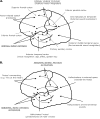The cognitive neuropsychology of auditory hallucinations: a parallel auditory pathways framework
- PMID: 18835839
- PMCID: PMC2879695
- DOI: 10.1093/schbul/sbn128
The cognitive neuropsychology of auditory hallucinations: a parallel auditory pathways framework
Abstract
Auditory hallucinations are generally defined as false perceptions. Recent developments in auditory neuroscience have rapidly increased our understanding of normal auditory perception revealing (partially) separate pathways for the identification ("what") and localization ("where") of auditory objects. The current review offers a reexamination of the nature of auditory hallucinations in schizophrenia using this object-based framework. First, the structural and functional organization of auditory what and where pathways is briefly described. Then, using recent functional neuroimaging data from healthy subjects and patients with schizophrenia, key phenomenological features of hallucinations are linked to abnormal processing both within and between these pathways. Finally, current cognitive explanations of hallucinations, based on intrusive cognitions and impaired source memory, are briefly outlined and set within this framework to provide an integrated cognitive neuropsychological model of auditory hallucinations.
Figures

References
-
- Belin P, Fecteau S, Bédard C. Thinking the voice: neural correlates of voice perception. Trends Cogn Sci. 2004;8:129–135. - PubMed
-
- Nayani TH, David AS. The auditory hallucination: a phenomenological survey. Psychol Med. 1996;26:177–189. - PubMed
-
- Baba A, Hamada H, Kocha H. Musical hallucinations in schizophrenia. 2. Relations with verbal hallucinations. Psychopathology. 2003;36:104–110. - PubMed
-
- Griffiths TD, Warren JD. What is an auditory object? Nat Rev Neurosci. 2004;5:887–892. - PubMed
-
- Kubovy M, Van Valkenburg D. Auditory and visual objects. Cognition. 2001;80:97–126. - PubMed
MeSH terms
LinkOut - more resources
Full Text Sources
Medical

